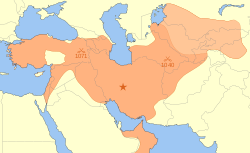सल्जक साम्राज्य
Warning: Value specified for "continent" does not comply
| |||||||||||||||||||||||||
|
| |||||||||||||||||||||||||
 upon the death of Malik Shah I | |||||||||||||||||||||||||
| राजधानी | Nishapur (1037–1043) Rey (1043–1051) Isfahan (1051–1118) Hamadan, Western capital (1118–1194) Merv, Eastern capital (1118–1153) | ||||||||||||||||||||||||
| भाषा(तः) | |||||||||||||||||||||||||
| Government | Monarchy[[Category:Former monarchies}}|सल्जक साम्राज्य, 1037]] | ||||||||||||||||||||||||
| Sultan | |||||||||||||||||||||||||
| - 1037–1063 | Toghrul I (first) | ||||||||||||||||||||||||
| - 1174–1194 | Toghrul III (last)[५][६] | ||||||||||||||||||||||||
| History | |||||||||||||||||||||||||
| - Tughril formed the state system | 1037 | ||||||||||||||||||||||||
| - Replaced by the Khwarezmian Empire[७] | 1194 | ||||||||||||||||||||||||
| क्षेत्रफल | |||||||||||||||||||||||||
| - 1080 est. | ३,९००,००० km2 १,५०५,७९८ sq mi | ||||||||||||||||||||||||
| |||||||||||||||||||||||||
| थौंयागु इले | Countries today
| ||||||||||||||||||||||||
सल्जक साम्राज्य वा सेल्जुक साम्राज्य छगू तुर्क-पारसी साम्राज्य ख। थ्व साम्राज्यय् तुर्की-ईरानी संस्कृति व सुन्नी धर्म दयाच्वन। थ्व साम्राज्यया पलिस्था ओगुज तुर्कया कानिक कबीलां यात। सल्जक साम्राज्यं थःगु मातृभूमि, अराल सागरया सिथं खुरासानय् हमला यात, व लिपा ईरानया मध्य भागय् दुहांवलः। थ्व धुंका इमिसं मालाजगर्डया ल्वापूइ बैजन्ताइन साम्राज्ययात बुकाः एनातोलियाय् कब्जा यात। तुग्रेल बेया शासनकालय् सेल्जुकतेसं बगदादय् स्थित अब्बासिद खलिफतय् राजनीतिक प्रभुत्व स्थापित यासें व्यावहारिक रूपय् मुस्मां हलिंया नेतृत्व थःगु ल्हातय् लाकलः। थःगु चरम उत्कर्ष बिले सेल्जुक साम्राज्यं पूर्वय् हिंदू कुश गुंझ्वः तक, पश्चिमय् एशिया माइनर व लेभान्त तक, उत्तरय् मध्य एशिया तक व दक्षिणय् यमन तक थःगु साम्राज्य विस्तार यातः।
सेल्जुक साम्राज्यया पलिस्था सन् १०३७स में तुग्रेल बे नं यानादिल। तुगरल सेल्जूक बेया माध्यमं सिंहासनय् च्वन। थ्व पद ओगुज तुर्कतेगु प्रमुखय् छगू खः। सेल्जुकतेसं मुस्मां हलिंयातः छधि यासें प्रथम व द्वितीय धर्मयुद्धय् महत्वपूर्ण भूमिका म्हितल। सेल्जुकतेत इरानी संस्कृति व फारसी भाषां यक्व प्रभावित यात व इमिसं तुर्की-ईरानी तजिलजिया दथुइ स्वापू दयेकेतः महत्वपूर्ण भूमिका म्हितलः। थ्व कथं, थ्व साम्राज्य इरानी संस्कृतियात एनातोलियन पठारय् स्थानांतरित यायेगु कारक नं जुवन। फारसी भाषा (अरबी स्वया) सांस्कृतिक रुपय् स्वतन्त्र जुया सेल्जुक साम्राज्यय् विस्तारित जुल। सेल्जुकतेगु थःगु स्थायी मुस्मां परम्परा वा साहित्यिक धरोहर मदूगुलिं इमिसं इस्लामय् थःगु फारसी गुरुतेगु सांस्कृतिक भाषायात नालाःकालः। थ्व कथं, फारसी भाषा व साहित्य सकल ईरानय् विस्तारित जुल व धार्मिक कार्य व शिक्षा त्वताः मेमेगु ख्यलय् अरबी भाषा इरानं लुप्त जूवन। विदेशी शत्रुतेगु संभावित हमलाया विरुद्ध सेल्जुक साम्राज्यया उत्तरी व उत्तर-पश्चिमी सीमाय् रणनीतिक क्षेत्रय् तुर्क वंशजया यक्व मनूतेत मेमेगु थासं हलः। थ्व थासय् न्हूगु जातिया स्थापित यायेगु ज्यायात थ्व क्षेत्रया तुर्कीकरण धाइ।
लिधंसा
[सम्पादन]- ↑ १.० १.१ Savory, R. M. and Roger Savory, Introduction to Islamic civilisation, (Cambridge University Press, 1976 ), 82.
- ↑ Black, Edwin, Banking on Baghdad: inside Iraq's 7,000-year history of war, profit and conflict, (John Wiley and sons, 2004), 38.
- ↑ ३.० ३.१ ३.२ C.E. Bosworth, "Turkish Expansion towards the west" in UNESCO HISTORY OF HUMANITY, Volume IV, titled "From the Seventh to the Sixteenth Century", UNESCO Publishing / Routledge, p. 391: "While the Arabic language retained its primacy in such spheres as law, theology and science, the culture of the Seljuk court and secular literature within the sultanate became largely Persianized; this is seen in the early adoption of Persian epic names by the Seljuk rulers (Qubād, Kay Khusraw and so on) and in the use of Persian as a literary language (Turkish must have been essentially a vehicle for everyday speech at this time)
- ↑ Concise encyclopedia of languages of the world, Ed. Keith Brown, Sarah Ogilvie, (Elsevier Ltd., 2009), 1110;Oghuz Turkic is first represented by Old Anatolian Turkish which was a subordinate written medium until the end of the Seljuk rule.".
- ↑ A New General Biographical Dictionary, Vol.2, Ed. Hugh James Rose, (London, 1853), 214.
- ↑ Grousset, Rene, The Empire of the Steppes, (New Brunswick:Rutgers University Press, 1988), 167.
- ↑ Grousset, Rene, The Empire of the Steppes, (New Brunswick:Rutgers University Press, 1988),159,161; "In 1194, Togrul III would succumb to the onslaught of the Khwarizmian Turks, who were destined at last to succeed the Seljuks to the empire of the Middle East."
